For ease of design, installation as well as for cost control, it is always best to install loops when a room or venue is being refurbished or newly built.
 No matter what type of design is used and no matter where the loops are installed, the end product has to comply with performance standards set forth by the International Electrotechnical Commission – IEC 60118-4. Any Hearing Loop installer must be familiar with those standards. At the end of the job, a Certificate of Conformity will be provided to the client.
No matter what type of design is used and no matter where the loops are installed, the end product has to comply with performance standards set forth by the International Electrotechnical Commission – IEC 60118-4. Any Hearing Loop installer must be familiar with those standards. At the end of the job, a Certificate of Conformity will be provided to the client.
Hearing Loop Design
Every hearing loop is different. These are custom designs that are adapted to the premises to be looped and are based on the findings of the hearing loop installer.
Briefly: An effective design yields a hearing loop that has consistent sound signal strength across the looped area. No matter where people sit, their listening experience is effortless without straining to hear. There are no dead zones where the signal fades or dies. There will be no interference noises or hums.
The design of a hearing loop is influenced by many factors. Therefore, experienced installers resolve their questions before making a decision on the type of loop that would be best for the premises. For example, among other concerns, they will
- ask what the intended use of the loop will be: Accommodate seated audiences like in conference rooms where chairs are moved around? Accommodate fixed-seated audiences like in theaters? One-on-one conversations such as at bank teller windows or information desks? It is important to provide the exact purpose.
- perform a site check, which includes an inspection of the floor, walls, ceiling and vents. They measure the area and take readings checking for existing background hums.
- locate other AV (audio-visual) equipment that the hearing loop must tie into.
- inspect the premises for competing electrical systems and equipment that could cause crackling or buzzing within a loop. How close is the mechanical equipment room?
- survey the surrounding outside area for electrical installations that could interfere, such as buried cables, electric substations etc.
- ask questions about the construction of the building. Maybe they want to see architectural drawings. What construction materials were used such as wood, stone or metal? Too much metal can drain off the signal, which affects the loop design.
- inquire about privacy issues? This will affect the loop design and the installer has to be aware. Magnetic loop energy spills over or “leaks.” People outside the looped area in a hallway or adjacent room could listen in on discussions with a T-coil equipped device.
- inquire about the location of additional loops. Signal leakage from additional loops that are located in close proximity to one another makes it possible to hear sound from multiple loops at the same time, which is not a desirable feature.
Complicating factors such as construction metals, existing background hums, signal spill-over and overlapping of signals with other close-by loops can be dealt with but they complicate the design, the installation and therefore the cost.
Three Basic Types of Looping Wire Layouts
See our section on Hearing Loop Basics for details on how Hearing Loops work.
Hearing loops are usually best installed at floor level, beneath the audience. In certain situations Loops can work best when installed above the audience.
The three types of layouts are described here.
It is always best to install loops when a room or venue is being refurbished or newly built. This gives installers the best access to the bare floor and speeds up the installation. Saving time also saves money.
Perimeter Loop
This is the simplest design for smaller rooms without any metal in the structure and where signal leakage and privacy issues are of no concern. A single wire loop is laid around the inside perimeter of the listening area. People sit within the outlined area or “in the loop.”
A regular wire (e.g. AWG No.12) under the floor (if there is a basement), or in a plastic molding around the baseboard, at the top of the wall or in the ceiling.
This maybe lower cost and could work better that installing the loop under the Carpeting.
In addition, the perimeter loop must be used if there is no Carpeting – the floor is made of laminate, is Terrazzo or is polished concrete.
In certain situations, a small notch can be cut into a concrete floor to install a loop wire. The wire is then covered with a compound. This cannot be done if the notch affects the tensile strength of the floor.
If it is a new facility, the wire can be installed in the flooring.
At the Minneapolis-St.Paul International Airport, the hearing loops are installed in the new Terrazzo Flooring. These loops work very well.
Again, after Perimeter Loop is installed – the Loop Amplifier and other Audio equipment is then installed and hooked up.
This diagram shows the basic design of a perimeter Hearing Loop. People sit within the loop. Diagram from the book: “What Did You Say?” by Monique Hammond
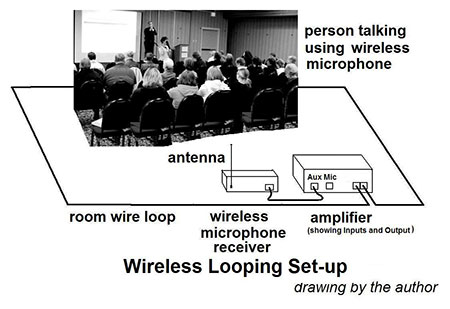
Under Carpet Loop Wire
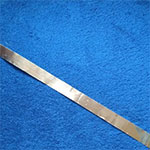
Loop wires are usually hidden under carpets and other floor coverings, such as wood or tiles. In order to eliminate ripples under carpeting or floor coverings, the looping “wire” is a flat copper strip, as shown here.
If it works best – a special flat wire can be installed on the floor underneath the Carpet and Pad.
This works best with Carpet Tiles or when the carpeting is being installed or replaced at a facility.
Single Array Loop
This type of loop can be used for larger rooms with “fixed” audiences – chairs are fixed in place – and where construction metal is of little or no concern. Privacy issues still exist. The loop wire is laid so that the listening area is subdivided into equal rectangles. A picture from the Loop Minnesota Photo Gallery shows what this might look like.
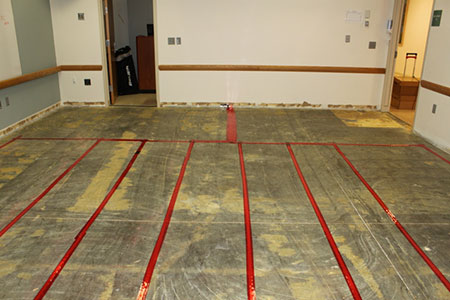
Phased Array Loops
Phased array loops can become quite complicated. They are best for dealing with problems such as construction metals, signal leakage and therefore privacy concerns and overlap issues with close-by loops. They work well in large venues where people might also move around.
The numbers and the off-setting of the wire rectangle arrays hold the secret to more consistent signal coverage across the listening area and make for reduced signal spills.
Depending on how well they rein in the signal leakage, they may be referred to as “low leak/spillage” or “very/ultra low leak/spillage”.
A “low-spill” phased array involves 2 sets of wire rectangles that are offset from each other. An “ultra-low spill” phased array involves more sets of skinnier rectangles.
The more technically inclined, might check out this brief video on phased array.
Hearing Loop Installation
 Hearing loops are best installed at floor level, beneath the audience. They are usually hidden under carpets and other floor coverings, such as wood or tiles. In order to eliminate ripples under carpeting or floor coverings, the looping “wire” is a flat copper strip, as shown here.
Hearing loops are best installed at floor level, beneath the audience. They are usually hidden under carpets and other floor coverings, such as wood or tiles. In order to eliminate ripples under carpeting or floor coverings, the looping “wire” is a flat copper strip, as shown here.
It is always best to install loops when a room or venue is being refurbished or newly built. This gives installers the best access to the bare floor and speeds up the installation. Saving time also saves money.
Case in point: Loops that are fitted into an existing space are usually hidden under carpets. This means that the carpet must be temporarily removed and re-laid once the job is done.
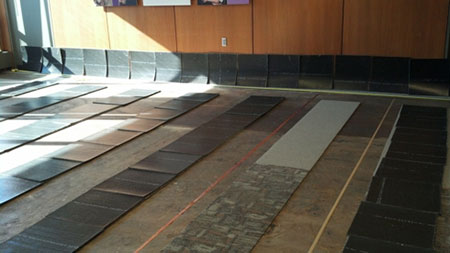
This picture from the Loop Minnesota Photo Gallery shows the installation of a hearing loop in the Board Room at the Courage Center – Allina Health. The floor covering consists of carpet “tiles,” which were removed so that the loop wire (yellow/orange bands) could be laid down.
If it is a new facility, the wire is installed before the Pad and Carpeting is laid down. Or if there is regular carpeting – the carpeting is temporarily removed. Loop Wire rectangles are then taped to the floor with the wires from each loop brought to the edge of the room near the Loop Amplifier. The carpeting is then re-installed and the Loop Amplifier and other Audio equipment is then installed and hooked up.
Finishing touches
At the end of the installation, the installer issues a Certificate of Conformity with the IEC 60118-4 standards. To make the loop accessible to all, the installer provides compatible loop receivers, microphones and headsets. The area will be marked with a sign that a hearing loop is installed. “T” stands for Telecoil.
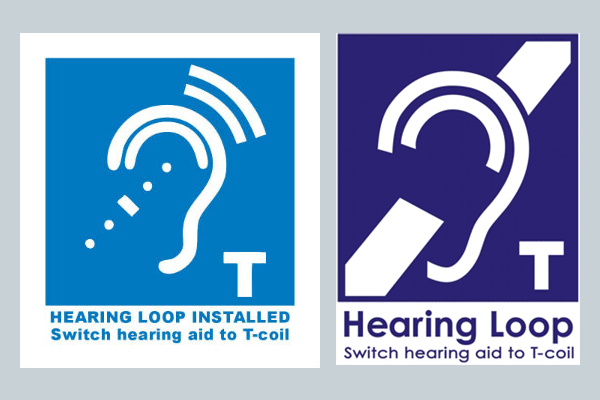
Do your own test:
Have the installer turn the loop on and have somebody speak into the microphone. Then take a walk through the area front to back, corner to corner, diagonally, around the perimeter – in every which way – as you listen in with your own telecoil-equipped hearing aids or by means of a portable (telecoil) loop receiver. How well do you hear and understand? The quality of the loop is in the clarity and consistency of the sound signal.
Tips on Vetting Hearing Loop Installers
The design and installation of a well-functioning hearing loop is kind of an art. It is a melting of technical know-how, the understanding of how to turn electro-magnetic energy into clear sound and, of course esthetics.
Unfortunately, substandard loops can easily give Looping, which is a worthwhile technology – a questionable reputation. Therefore, it is important to do some basic screening of vendors.
- Is the specialist familiar with the IEC 60118-4 standards?
- Will the vendor company do the design and work itself or will subcontractors be involved? Who would that be?
- How many loops has the installer successfully completed? Ask for a list. Are you allowed to contact some of these former clients? At that time, one might inquire about a demonstration and costs.
- If any of the sites involve public places such as a place of worship or a library, check on upcoming events and attend for the purpose of checking out the loop quality.
- What is the general attitude of the installer? For instance: Does he/she do a site inspection, takes area measurements, checks on existing background sound, asks about construction materials such as metals, considers privacy concerns etc.
- Any ideas on the details of the work? What type of loop would be appropriate? When could work begin and how long will it take?
- What will the cost be?

picture by pixabay.com
Hearing Loop Costs
Unfortunately, there are no clear answers as every loop is a custom design and comes with compatible loop receivers and headsets. Consider competing bids. Also, you might find financial help available from generous donors or from groups such as foundations or service groups?
The cost is determined by:
- the size of the area to be looped, which makes sense. It is cheaper to loop an average sized meeting room for a few thousand dollars than a convention hall for tens-of-thousands of dollars and more.
- the obstacles that have to be overcome, such as area size, metal drain, signal leakage issues etc. as these determine the design features of the loop.
- site preparation. Does carpeting or floor covering have to be removed, cut and relayed or replaced? This why it is best to install loops when the area is refurbished or even newly built.
- the complexity of the design. Phased array loops are more complicated and take more time and material to install than perimeter or single array loops.
- as is true for any job, labor and materials all contribute to the costs. For hearing loops one of the more costly pieces of equipment are the amplifiers. These are electrical current amplifiers – NOT the more familiar volume or loudness amplifiers.
The value of hearing loops goes beyond costs. When deliberating the installation of a hearing loop, it is good to remember that once a loop is installed it is permanent. It does not need cleaning or battery replacements.
Loops that are installed according to specifications fulfill the requirements of the Americans with Disabilities Act (ADA) for accessibility for those with hearing loss. Loop receivers make the loop also accessible to those without hearing aids but who benefit from listening assistance especially in background noise.
Hearing loops can be viewed as a customer service for the 20% of the population with hearing challenges. It is an inclusive technology that makes businesses, places of worship and other venues accessible to all, which deserves to be advertised.
